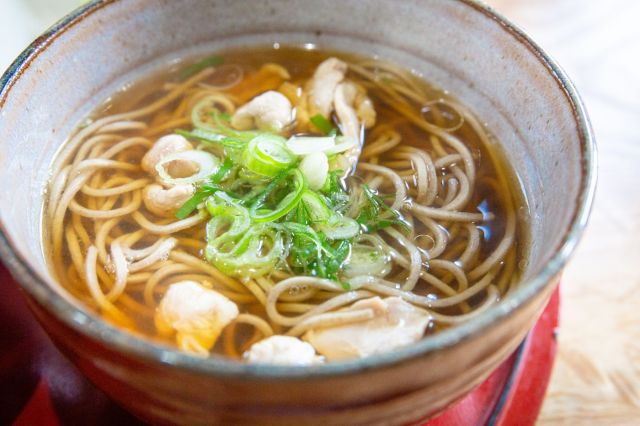
Japan’s etiquette police weigh in on an unusual trend spotted amongst diners.
There are a lot of things to learn when it comes to Japanese dining etiquette. Where do you start, for instance, when presented with multiple dishes? And what bowls are okay to be picked up?
People in Japan are usually guided on these points from a very young age, but once you move past these basic rules, there’s still a whole world of manners to discover, and some of it is so obscure it even comes as a surprise to locals.
One such rule that has people scratching their heads recently is the rare custom of turning your bowl upside down after eating at a restaurant. Known as fusedon (literally “facedown bowl”), this unusual practice is believed to have originated in Yamagata Prefecture, where yamabushi, mountain-dwelling warrior priests, were said to have started the trend.
▼ Fusedon requires a donburi (oversized rice bowl), which makes up the “don” in its name, like the ones seen at ramen restaurants.
ラーメン店に対する敬意だそうです。
— 麺庵 小島流 (@menankojimaryu) August 18, 2015
"伏せ丼"(爆笑) pic.twitter.com/jVIXvPo62s
Strangely enough, the practice appears to have since died out there, as this 2016 survey of 623 diners shows the niche custom has been recorded in Tokyo, Ibaraki, Aichi, Chiba (marked in yellow on the map below), and Kanagawa (marked in blue).
▼ 0.8-percent of respondents said they took part in the practice (yellow), while 0.3-percent had seen it being done (blue)
噂の「伏せ丼」は実在するのか 「見たことない」98.7%...えっ、残りは!? - https://t.co/QE8WIhbbQg @Jtown_net pic.twitter.com/xmZBPES17J
— Jタウンネット編集部 (@jtown_net) March 17, 2016
The survey showed that the custom was largely unknown, with 98.7-percent of respondents only hearing about it for the first time and green showing the regions where the practice was yet to be seen. In the five years that have passed since the survey, however, knowledge of the practice has slowly spread around the country through photos on social media.
金曜日はカレーの日、と思いながらバイクで走っていると、昼営業のみの神戸最強博多ラーメン屋さんに灯りが。バリカタ、替え玉。あまりの旨さに感謝の「伏せ丼」。 pic.twitter.com/ZmmTMkw3Tm
— Jun OKUNO (奥野潤) (@junokuno) February 26, 2016
▼ Fusedon isn’t solely restricted to rice bowls, as it can involve large one-dish meals like omuraisu (omelette rice) as well.
念願のオムライス!美味かったから伏せ丼しといた(専門家による指導を受けています。真似しないで下さい。)!マジギルティ!! pic.twitter.com/m4msaTgphF
— フランス語で虹 (@ryo927ryo) June 6, 2016
▼ Most recently, fusedon has been exerting its influence on popular culture, with figurines and game characters turning their bowls over post-meal.
伏せ丼するイノセンティア。ぷらべに来た可動フィギュアにはラーメンを食べていただく事に(´ー`)#FAガール pic.twitter.com/30B83pNfs4
— Experten@TFO14 (@expertenmodels) March 31, 2018
https://twitter.com/koutetsujouki/status/1266849434140205057定食屋ワールドで遊んだ。
— joniburn (@joniburn) April 7, 2019
レムリアさんを見習って室外機を蹴ったり伏せ丼したり #バチャッター pic.twitter.com/LLHcahbVeU
So why are people turning their bowls over in the first place, and should it be something that more people ought to take part in?
According to those who’ve taken part in the practice, fusedon is meant to be a show of gratitude to the chef, as the bowl is only upturned when completely empty, indicating that every last skerrick of the meal was thoroughly enjoyed. However, people are now beginning to wonder if it’s becoming more of a social media trend, as the shock of seeing upturned bowls results in increased shares and views.
Either way, the consensus amongst chefs and diners is that fusedon has no place in the dining world, as it’s messy, unhygienic, and causes trouble for staff who have to grapple with the upturned bowls when clearing them away.
“Fusedon is no good because it’s self-satisfying only for customers and annoying to staff.”
“Turning your bowl upside down is something a child would do after eating.”
“This is a terrible idea. The bowl might be empty but the oil from it would still mark the table.”
“It’s a false virtue — the proper manners would be to compensate the restaurant afterwards for damaging their table.”
“This is the opposite of good manners.”
Interestingly, one Twitter user shared an image from the Showa Citizens’ Etiquette guide issued by the Education Council in 1938 as teaching material for secondary schools. This page clearly states that one should not turn their “chawan” (teacup/rice bowl) over after consuming tea.
「伏せ丼」ってなんですのん(笑)
— アネザイチカ (@nomoretakuan) March 12, 2021
『昭和国民礼法要項』で禁止されてますやん
(昭和十三年の教育審議会で発案、十六年四月十五日に全国的に通牒が発せられ中等諸学校の礼法の指導教材として用いられたテキスト) pic.twitter.com/xiHsrp2Bjy
So next time you’ve polished off the final grain of rice in your beef bowl or slurped up the last sip of broth from your ramen bowl, don’t follow the practice of heathens by turning your bowl over and leaving the table.
Like mixing your wasabi with your soy sauce, it’s an act that chefs don’t appreciate, so simply say “gochisosama deshita” (thank you for the meal) when leaving the table to show your appreciation and put a smile on their faces instead.
Source: Twitter/#伏せ丼, J-Town Net, Kurotsubaneko No Computer Nikki 2nd Edition
Top image: Pakutaso
● Want to hear about SoraNews24’s latest articles as soon as they’re published? Follow us on Facebook and Twitter!
Trackbacks
- Trackback URL
Trending Now
- McDonald’s new Happy Meals offer up cute and practical Sanrio lifestyle goods 31 views
- Studio Ghibli releases new action figures featuring Nausicaä of the Valley of the Wind characters 12 views
- All-you-can-drink Starbucks and amazing views part of Tokyo’s new 170 meter-high sky lounge 11 views
- Studio Ghibli glasses cases let anime characters keep an eye on your spectacles 5 views
- Katsudon vs. tonkatsu vs. katsu sandwich – What’s the best way to eat pork cutlet in Japan? 4 views
- Arrest proves a common Japanese saying about apologies and police 3 views
- Kyoto’s 100 Demons yokai monster parade returns! 3 views
- Super Nintendo World expansion gets delayed for several months at Universal Studios Japan 3 views
- We try out “Chan Ramen”, an underground type of ramen popular in the ramen community 2 views
- Hamster abandoned at Tokyo ramen restaurant gets new home 2 views

 Should you add wasabi to your soy sauce at a sushi restaurant?
Should you add wasabi to your soy sauce at a sushi restaurant? Awesome mountain of meaty goodness now at beef bowl restaurant in Tokyo’s Akihabara and Shimbashi
Awesome mountain of meaty goodness now at beef bowl restaurant in Tokyo’s Akihabara and Shimbashi Japanese Twitter rolls eyes at book teaching “manners 90 percent of Japanese people don’t know”
Japanese Twitter rolls eyes at book teaching “manners 90 percent of Japanese people don’t know” Ramen manners debate: Should you put your used napkins into your bowl after you eat?
Ramen manners debate: Should you put your used napkins into your bowl after you eat? Ramen and dekotora come together at this restaurant in Japan
Ramen and dekotora come together at this restaurant in Japan McDonald’s new Happy Meals offer up cute and practical Sanrio lifestyle goods
McDonald’s new Happy Meals offer up cute and practical Sanrio lifestyle goods Studio Ghibli releases new action figures featuring Nausicaä of the Valley of the Wind characters
Studio Ghibli releases new action figures featuring Nausicaä of the Valley of the Wind characters All-you-can-drink Starbucks and amazing views part of Tokyo’s new 170 meter-high sky lounge
All-you-can-drink Starbucks and amazing views part of Tokyo’s new 170 meter-high sky lounge Studio Ghibli glasses cases let anime characters keep an eye on your spectacles
Studio Ghibli glasses cases let anime characters keep an eye on your spectacles Katsudon vs. tonkatsu vs. katsu sandwich – What’s the best way to eat pork cutlet in Japan?
Katsudon vs. tonkatsu vs. katsu sandwich – What’s the best way to eat pork cutlet in Japan? Arrest proves a common Japanese saying about apologies and police
Arrest proves a common Japanese saying about apologies and police Kyoto’s 100 Demons yokai monster parade returns!
Kyoto’s 100 Demons yokai monster parade returns! Super Nintendo World expansion gets delayed for several months at Universal Studios Japan
Super Nintendo World expansion gets delayed for several months at Universal Studios Japan We try out “Chan Ramen”, an underground type of ramen popular in the ramen community
We try out “Chan Ramen”, an underground type of ramen popular in the ramen community Hamster abandoned at Tokyo ramen restaurant gets new home
Hamster abandoned at Tokyo ramen restaurant gets new home More foreign tourists than ever before in history visited Japan last month
More foreign tourists than ever before in history visited Japan last month Disney princesses get official manga makeovers for Manga Princess Cafe opening in Tokyo
Disney princesses get official manga makeovers for Manga Princess Cafe opening in Tokyo Starbucks reopens at Shibuya Scramble Crossing with new look and design concept
Starbucks reopens at Shibuya Scramble Crossing with new look and design concept Beautiful new Final Fantasy T-shirt collection on the way from Uniqlo【Photos】
Beautiful new Final Fantasy T-shirt collection on the way from Uniqlo【Photos】 Is the new Shinkansen Train Desk ticket worth it?
Is the new Shinkansen Train Desk ticket worth it? Foreign English teachers in Japan pick their favorite Japanese-language phrases【Survey】
Foreign English teachers in Japan pick their favorite Japanese-language phrases【Survey】 Beautiful Sailor Moon manhole cover coasters being given out for free by Tokyo tourist center
Beautiful Sailor Moon manhole cover coasters being given out for free by Tokyo tourist center Studio Ghibli releases Kiki’s Delivery Service chocolate cake pouches in Japan
Studio Ghibli releases Kiki’s Delivery Service chocolate cake pouches in Japan Japan’s bone-breaking and record-breaking roller coaster is permanently shutting down
Japan’s bone-breaking and record-breaking roller coaster is permanently shutting down New definition of “Japanese whiskey” goes into effect to prevent fakes from fooling overseas buyers
New definition of “Japanese whiskey” goes into effect to prevent fakes from fooling overseas buyers Our Japanese reporter visits Costco in the U.S., finds super American and very Japanese things
Our Japanese reporter visits Costco in the U.S., finds super American and very Japanese things Studio Ghibli unveils Mother’s Day gift set that captures the love in My Neighbour Totoro
Studio Ghibli unveils Mother’s Day gift set that captures the love in My Neighbour Totoro Domino’s Japan now sells…pizza ears?
Domino’s Japan now sells…pizza ears? New Japanese KitKat flavour stars Sanrio characters, including Hello Kitty
New Japanese KitKat flavour stars Sanrio characters, including Hello Kitty One of Tokyo’s most famous meeting-spot landmarks is closing for good
One of Tokyo’s most famous meeting-spot landmarks is closing for good Kyoto creates new for-tourist buses to address overtourism with higher prices, faster rides
Kyoto creates new for-tourist buses to address overtourism with higher prices, faster rides Sales of Japan’s most convenient train ticket/shopping payment cards suspended indefinitely
Sales of Japan’s most convenient train ticket/shopping payment cards suspended indefinitely Sold-out Studio Ghibli desktop humidifiers are back so Totoro can help you through the dry season
Sold-out Studio Ghibli desktop humidifiers are back so Totoro can help you through the dry season Japanese government to make first change to romanization spelling rules since the 1950s
Japanese government to make first change to romanization spelling rules since the 1950s Ghibli founders Toshio Suzuki and Hayao Miyazaki contribute to Japanese whisky Totoro label design
Ghibli founders Toshio Suzuki and Hayao Miyazaki contribute to Japanese whisky Totoro label design Doraemon found buried at sea as scene from 1993 anime becomes real life【Photos】
Doraemon found buried at sea as scene from 1993 anime becomes real life【Photos】 Tokyo’s most famous Starbucks is closed
Tokyo’s most famous Starbucks is closed One Piece characters’ nationalities revealed, but fans have mixed opinions
One Piece characters’ nationalities revealed, but fans have mixed opinions We asked a Uniqlo employee what four things we should buy and their suggestions didn’t disappoint
We asked a Uniqlo employee what four things we should buy and their suggestions didn’t disappoint Princesses, fruits, and blacksmiths: Study reveals the 30 most unusual family names in Japan
Princesses, fruits, and blacksmiths: Study reveals the 30 most unusual family names in Japan One of Japan’s best ramen chains now has a VR game that lets you cook their noodles【Video】
One of Japan’s best ramen chains now has a VR game that lets you cook their noodles【Video】 Are you game enough to eat Fire Ramen at this Japanese restaurant in Kyoto?
Are you game enough to eat Fire Ramen at this Japanese restaurant in Kyoto? We Put A Bowl of Tonkotsu Ramen into a Rice Ball: Japan’s new demonic combini temptation
We Put A Bowl of Tonkotsu Ramen into a Rice Ball: Japan’s new demonic combini temptation How to avoid queues at this Ichiran ramen restaurant in Japan
How to avoid queues at this Ichiran ramen restaurant in Japan What?!? Turns out kids eat for free at one of Japan’s best ramen chains, and hardly anyone knew
What?!? Turns out kids eat for free at one of Japan’s best ramen chains, and hardly anyone knew Japanese restaurant serves extra wide noodles next to Tokyo Station
Japanese restaurant serves extra wide noodles next to Tokyo Station This popular limited-time mango yogurt shaved ice in Taiwan is everything you need this summer
This popular limited-time mango yogurt shaved ice in Taiwan is everything you need this summer Japan’s first-ever wanko soba conveyor belt restaurant opens in Tokyo
Japan’s first-ever wanko soba conveyor belt restaurant opens in Tokyo New Japanese bowl-shaped donburi rice cooker cooks rice and toppings at the same time
New Japanese bowl-shaped donburi rice cooker cooks rice and toppings at the same time Japanese beef bowl chain Matsuya now lets you exchange your rice for a salad, for free
Japanese beef bowl chain Matsuya now lets you exchange your rice for a salad, for free Pizza Hut creates Putting our Soul into Every Bite Ramen Pizza with famous Japanese ramen chain
Pizza Hut creates Putting our Soul into Every Bite Ramen Pizza with famous Japanese ramen chain This Tokyo ramen restaurant is the first to ever receive a Michelin dining guide star
This Tokyo ramen restaurant is the first to ever receive a Michelin dining guide star Kentucky fried rice bowl – KFC’s Kentadon expands throughout east Japan
Kentucky fried rice bowl – KFC’s Kentadon expands throughout east Japan Japanese beef bowl chain Yoshinoya releases new canned, ready-to-eat rice bowls 【Taste Test】
Japanese beef bowl chain Yoshinoya releases new canned, ready-to-eat rice bowls 【Taste Test】 Tonkotsu ramen rice bowl blows our minds, makes us appreciate noodles in a new light
Tonkotsu ramen rice bowl blows our minds, makes us appreciate noodles in a new light Japanese pork cutlet chain unveils its latest fusion food: cornflake chicken katsu bowls!
Japanese pork cutlet chain unveils its latest fusion food: cornflake chicken katsu bowls! Tokyo restaurant offers amazing sushi lunch deal for less than 5 bucks
Tokyo restaurant offers amazing sushi lunch deal for less than 5 bucks
Leave a Reply